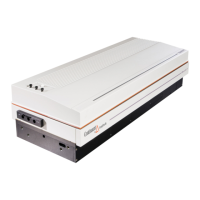3
1.1.2 Q-switch Buildup Time: Unseeded Operation
The Q-switch is included in the host resonator to initially inhibit lasing as the stored energy in
the laser rod increases due to flashlamp emission. This ensures that the Nd:YAG rod in the host
resonator has stored as much energy as possible. At full power this stored energy level can translate
into a single pass ("small signal") gain in excess of 50.
When the stored energy in the Nd:YAG rod is at a maximum the Q-switch may be opened.
Any light in the cavity possessing the proper frequency characteristics (ie. frequency within the gain
bandwidth of Nd:YAG and resonant with a longitudinal mode of the host cavity) and spatial
characteristics (ie. "on axis") of the host resonator is then repeatedly amplified by the Nd:YAG gain
media. In the unseeded host this initial light within the cavity is broadband spontaneous noise
emission from the Nd:YAG oscillator and amplifier rods. The spectral features of this noise
emission are given by the fluorescence gain curve of Nd:YAG shown in Figure 1-2. This relatively
weak spontaneous noise emission radiates in all directions leaving only a small power level
(-nanowatts) sufficiently on axis to experience resonant amplification.
Consequently, as the Q-switch opens, this low level spontaneous emission must make a
sufficient number of round trips through the Nd:YAG gain media to reach a fluence level
comparable to the characteristic saturation intensity for Nd:Y$*:LWKDVPDOOVLJQDOJDLQåSHU
pass, and accounting for output coupling losses, the pulse buildup typically requires about 12
resonator roundtrips. Given the speed of light and a resonator roundtrip length of 1.2 meters,
12resonator roundtrips corresponds to approximately 45 nsec.
When the amplified spontaneous emission reaches the saturation fluence, significant energy is
extracted from the Nd:YAG rod lowering the gain to the large signal value of approximately 2.5 to
4 per pass. At this time the laser pulse begins to be emitted from the host laser. The observed
output pulse width corresponds to the number of roundtrips required for circulating photons to
extract all the energy stored in the Nd:YAG oscillator rod. The time from when the Q-switch opens
until the laser pulse is emitted is termed the "Q-switch pulse build-up time".
1.1.3 Q-switch Buildup Time: Seeded Operation
During seeded operation very narrow linewidth (Ðν -5 kHz) laser emission of >1 milliwatt is
directed into the host laser cavity on axis. If this "seed" emission is near the frequency of a host
laser longitudinal mode, it will be resonantly amplified by the host when the Q-switch opens. Since
the seed emission is more than 6 orders of magnitude stronger than the spontaneous noise, the Q-
switch pulse builds up sooner out of the seed emission than the spontaneous emission.
Furthermore, when the amplified seed emission reaches the saturation intensity level, the gain
in the oscillator rod is quickly reduced from the small signal level (>50) to the large signal level (2.5
to 4). This reduction in gain inhibits further amplification of spontaneous emission keeping it at a
low level relative to the seeded output pulse. The difference in time between when a Q-switch pulse
is emitted in seeded operation versus unseeded operation is termed the "build-up time reduction".
As a general rule, if the reduction in Q-switch build-up time is greater than a Q-switched pulse
width (FWHM) there will be at least 1000 times more energy in the seeded longitudinal mode
frequency than in any other longitudinal mode.

